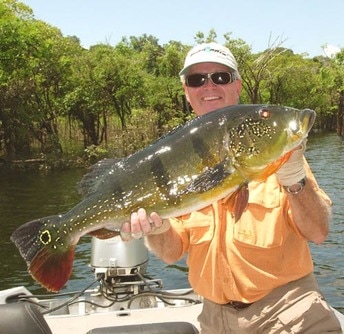 The author with a huge Brazilian peacock bass. Photo © Ken Schultz The author with a huge Brazilian peacock bass. Photo © Ken Schultz By Ken Schultz Someone recently asked me what I thought was the most exciting freshwater sportfish. I said it may be peacock bass. I had to say “may be” instead of “is” because I haven’t caught all of the world’s top freshwater gamefish. My life list does not include the (Argentinian) dorado, Niugini bass, mahseer, or taimen, for example, the first two of which I’ve heard great things about. But from what I’ve seen, the peacock bass is in a class of its own, especially when caught in its native flooded rain forests of South America. How good is it? If you tied identical-size peacock bass and largemouth bass tail-to-tail, the peacock would quickly drown the largemouth. As it happens neither of these sportfish are actually “bass.” And, as it happens, there are at least three, and perhaps more, species of fish that are called “peacock bass” but which are actually distinct species.
The imported peacock bass that exists in lakes and canals of south Florida, for example, is the butterfly peacock bass, which is not known to grow larger than 12 pounds, while the species that grows to at least 30 pounds and produces the gigantic specimens that you see in photos being held by deliriously happy anglers, is the speckled peacock bass. The first time that I ever fished for peacock bass, which was in the mid-1980s in Venezuela, I was told by the local guide that when I caught a peacock, I should let it swim around on my line because that would attract other peacocks, and my fishing partner, by casting behind my hooked fish, could also catch one. I have seldom seen that work but I have seen pairs of peacock bass chasing a lure and I’ve caught two peacocks at one time on the same lure. In Venezuela I also observed that the guide occasionally splashed the water with his hand in an attempt to get peacock bass to investigate. This, too, has never seemed to be productive, but I can say with absolute certainty that peacocks are attracted to noise, which is why the lure for catching giant speckled peacock bass (15 pounds and over) is a large floating surface plug with one or two propeller blades. Luhr Jensen’s Woodchopper and Amazon Ripper plugs are mainstays, and there’s no doubt that such lures “call” the big boys out of hiding. When the big boys come out of hiding they explode on the water-frothing lure. Imagine the sound created by a cinder block being dropped off a bridge and striking the water’s surface. The strike of a large peacock bass on a surface lure sounds like that. It’s stunning. You’d better have a good grip on your rod when it happens, because this baby has swapped ends and is already smoking back to the trees. Stop me if you can... Sometimes you can. If you do, the fish is likely to run right at the boat at heartbreak speed and you’ll momentarily think you lost it. Often, and this is almost as thrilling as the ferocious topwater strike, the fish will jump. The biggest ones don’t jump as often as the low- to mid-‘teeners, but it’s a show. One of my favorite fishing memories is seeing an 18-pound peacock bass jump 4 or 5 feet out of the water on a tributary to the Madeira River in Brazil. I yelled involuntarily with surprise when it cleared the surface, as it seemed gargantuan to me in that split-second view. We anglers arbitrarily assign extra value to fish that jump. Largemouth bass wouldn’t be quite so popular if they did not have acrobatic tendencies. Walleyes would be more popular if they did. Carp grow much larger than bass and have far more stamina; if they jumped like a bass, their stature would be greatly elevated. Although being plant eaters instead of carnivores their stature cannot be elevated too far. Chinook salmon, because of their great strength and speed, would probably be the hand’s down all-time favorite North American sportfish if only they struck topwater lures and jumped out of the water. That peacock bass are also one of the prettiest of freshwater gamefish really seals the whole issue. Their appearance is much more striking than bass, walleye, pike, salmon, and most of the trouts. Someday, when global warming makes Ohio’s climate similar to that of present-day Florida, these great fish will be more widely available in the United States. Until then, you have to make a pilgrimage to Brazil, or possibly Columbia, where the biggest and baddest of these dudes are waiting to annihilate a Woodchopper. Comments are closed.
|
WelcomeThanks for checking out my blog commentary on all things fishing-related. Please follow, share, and enjoy, but make sure you get out on the water as often as possible. Good fishing! Categories
All
Text and photos on this blog copyright © Ken Schultz. Text may not be reproduced. Bloggers may only use photos with credit to kenschultz.com and links to the original post on this site. Contact me for permission to use photos for commercial use.. Thanks for your cooperation.
|
 RSS Feed
RSS Feed